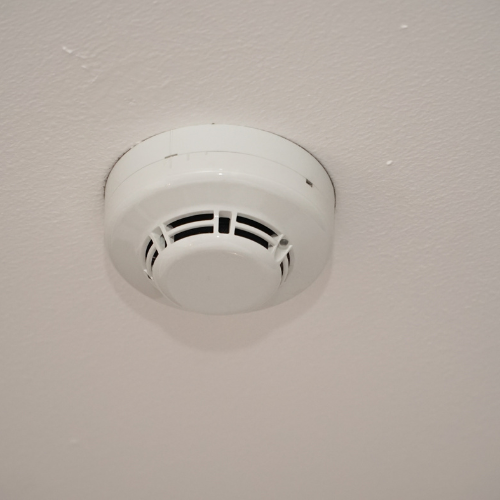Home / Electrical / CO & Smoke Detectors
Protect What Matters in the Rio Grande Valley
CO & Smoke Detector Installation, Replacement & Testing
Treviño Repairs installs and replaces smoke and carbon monoxide detectors the right way—proper locations on every level and outside/inside sleeping areas, clean wiring, and interconnection so all alarms sound together. We assess your layout, confirm power source (hardwired with battery backup or sealed battery), add or reuse circuits when appropriate, and install combination units where they make sense. After mounting, we label install dates, test with the manufacturer procedure, review simple maintenance (monthly tests, battery checks, typical 7–10 year replacement cycles), and can provide smart/monitored options when needed—so your RGV home or business stays code-compliant and protected.

Code-Compliant Coverage for Homes & Businesses
Services for CO & Smoke Detectors
Treviño Repairs installs, replaces, and tests smoke and carbon-monoxide detectors with proper placement, clean wiring, and full-home interconnection—so every alarm speaks up when it matters. We verify locations, power source, and interconnect method, then label dates and review simple maintenance for your RGV property.
We install & replace:
- Smoke detectors (photoelectric/ionization) in bedrooms, halls, and each level
- CO detectors near sleeping areas and by attached garages
- Combination CO/Smoke units where appropriate
- Hardwired (120V) with battery backup and sealed 10-year battery models
- Interconnected systems (wired or wireless bridges) for whole-home alerting
- Smart detectors (app alerts, self-tests) when requested
Code items & setup (as applicable):
- Location verification per current standards (outside/inside sleeping areas; every level)
- Correct mounting height/clearances; avoid ducts, kitchens, and steamy baths
- Interconnect testing (all should sound together)
- Circuit additions or reuse when appropriate; clean junctions and labeling
- Date labeling and replacement schedule (typically ~10 years for smoke, ~7–10 for CO—per manufacturer)
Testing, maintenance & options:
- Post-install functional tests and homeowner walkthrough
- Monthly test/reminder setup; battery checks/replacements
- Replacement planning for aging/yellowed or nuisance-prone devices
- Monitoring/smart notifications integration when needed
CO vs. Smoke Detectors—Placement, Power & Replacement
Smoke detectors sense particles from fire, while carbon-monoxide (CO) detectors monitor an invisible, odorless gas—so you need both, placed correctly and interconnected to alert the whole home. Best practice is hardwired with battery backup (or sealed 10-year battery where wiring isn’t feasible), with smoke alarms on ceilings or high on walls in bedrooms, hallways, and every level; CO detectors near sleeping areas and by attached garages (but away from kitchens, ducts, or steamy baths). Test monthly, keep vents and sensors clear of dust, and plan timely replacement—typically about 10 years for smoke and 7–10 years for CO, per manufacturer guidance. Treviño Repairs verifies locations, wiring, and interconnection, then labels dates and reviews simple upkeep for your RGV property.

Know the Warning Signs in the Rio Grande Valley
When to Replace or Upgrade CO & Smoke Detectors
If your alarms chirp even after a fresh battery, fail a monthly test, or only some units sound during an interconnect test, it’s time for service. Detectors past their lifespan (smoke ~10 years; CO ~7–10 years per manufacturer), frequent nuisance alarms, yellowed/corroded housings, missing battery backups, or changes to your home—new bedroom, finished space, attached garage, or new gas appliances—also signal a needed upgrade. Treviño Repairs can verify locations to current standards, test wiring/interconnects, add or relocate devices, label install dates, and set you up with reliable protection for your RGV home or business.
What to Expect with Treviño Repairs
Our Lighting Installation & Upgrade Process
Assess & Plan. We confirm proper locations per current standards (bedrooms, halls, every level), review power source (hardwired with backup or sealed battery), and choose smoke, CO, or combo units.
Protect & Prep. We use shoe covers and drop cloths, safely shut off power if hardwired, and verify boxes, wiring, and interconnect paths.
Remove & Inspect. We remove old alarms, check date codes and compatibility, inspect wiring and junctions, and note any code or placement corrections.
Install & Interconnect. We mount at correct heights/clearances, wire cleanly, add wireless bridges if needed, and interconnect so all alarms sound together.
Label & Power Up. We restore power, label install dates and locations, and document models for your replacement schedule.
Test & Verify. We perform functional tests on each unit, verify whole-home interconnect, and review nuisance-reduction features where applicable.
Clean Up & Walkthrough. We tidy the area and review monthly testing, battery practices, typical replacement timelines (smoke ~10 years; CO ~7–10 per manufacturer), and smart/monitoring options for your RGV property.

Real Stories. Real Results.
What Our Customers Are Saying
EXCELLENTTrustindex verifies that the original source of the review is Google. Very professional. Got the job done very quickly. Would definitely recommend.Posted onTrustindex verifies that the original source of the review is Google. Very professional and answered all questions I asked. Will call again if I have other electrical problems.Posted onTrustindex verifies that the original source of the review is Google. Great Service: We had a leak and couldn’t figure out where it was coming from. Eduardo took his time to find the source, kept me updated throughout the process, and finally discovered it was an AC leak. Just last week, we had paid another company to fix the same issue, but they didn’t do the job correctly. Eduardo explained everything clearly, offered to correct the problem, and even charged less than what we had previously paid the other company. Once he identified the leak, he made sure it was completely taken care of. I called today, and they arrived in less than an hour—excellent service! Eduardo was the best, and I highly recommend him company.Posted onTrustindex verifies that the original source of the review is Google. Great service, super fast and convenient. Valente came out same day, identified the problem in minutes, and built a solution in less than an hour. We appreciated that he provided options and up front pricing.Posted onTrustindex verifies that the original source of the review is Google. Had an electrical issue and called so many electricians. None were available and some didn’t answer at all or return calls. Called Treviños Plumbing, Electric, and HVAC and they scheduled us right away. Our technician, David, was very professional, friendly, patient, and fixed the issue! Great service! Thank you so so much! Highly recommended!!! Hopefully we won’t have any other issues for a while but if we do, I’m definitely contacting Trevino’s!Posted onTrustindex verifies that the original source of the review is Google. Great work by Eduardo, explained the problems thoroughly and fixed them quicklyPosted onTrustindex verifies that the original source of the review is Google. Had an emergency with my water pipe outside of my home. From what started with a leak water would not stop running, ended up being a whole fountain.(Water everywhere). Super panicked I call Trevino’s and they came to the rescue as quick as possible. So grateful and thankful for David D, he took our call and fixed our issue. Super fast service and arrival time 5 stars all the way. Thankyou so much.Posted onTrustindex verifies that the original source of the review is Google. Lee cordero from brownsville tx.This company went above and beyond for my dad.We called 3 other companys that were no show.This company is the best and they really work with your schedule and there super affortable and take there time to do the best work possible. My dad a vet and he has been dealing with this ac issue for months this company and there techos took there time for my dad when no else did hands of best company to go with .I highly recommend them .Thank you Tervino team. Antonio finally put my family at ease with this ongoing issue that no one else could figure out.Posted onTrustindex verifies that the original source of the review is Google. 5 stars, fantastic service! I will only hire this company from now on!!!!Posted onTrustindex verifies that the original source of the review is Google. Jiovanni, came by today for a call back at our house. He was pleasant professional, and quickly took care of the problem. We were very impressed with the service and the company. I praise God for the quick response, thank you again!Verified by TrustindexTrustindex verified badge is the Universal Symbol of Trust. Only the greatest companies can get the verified badge who has a review score above 4.5, based on customer reviews over the past 12 months. Read more
CO & Smoke Detector Questions, Answered
Straightforward answers before you book—symptoms, costs, fixes.
Do I need both smoke and CO detectors, or are combo units OK?
You need protection for both hazards. Combo units are fine when properly placed and powered; in some layouts, separate smoke (bedrooms/halls) plus CO near sleeping areas and by attached garages is the better fit. We’ll recommend the right mix for your home.
Hardwired or battery-only—what’s best?
Best practice is hardwired with battery backup for whole-home interconnection. Where wiring isn’t feasible, sealed 10-year battery models are a solid option. We verify power sources and interconnect so all alarms sound together.
How long do detectors last?
Most smoke alarms are about 10 years and CO detectors 7–10 years—always follow the manufacturer’s date code and guidance. If yours are past that or yellowed, replace them.
Why does my alarm chirp after changing the battery?
Chirping can mean end-of-life, a weak/incorrect battery, dust in the sensor, or wiring/interconnect issues. We can test, clean, verify power, and confirm if replacement is due.
Where should detectors be installed?
Smoke: on ceilings/high walls in every bedroom, outside sleeping areas, and on every level. CO: near sleeping areas and by attached garages (away from kitchens/steamy baths). We place and label units to current standards and test that all alarms sound together.




